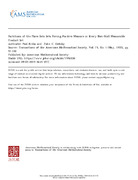| dc.description.abstract | . The following question was posed by D. Maharam: Can
one divide the unit square into two or more measurable sets each of which has
a non-null intersection with every product set A XB of positive measure,
where A and B are subsets of the unit interval?
In this paper we construct a class of such partitions of the plane, including
some that retain the property under various transformations. Not all known
partitions are included in this class; in particular it does,not include one
found by Maharam and A. H. Stone (unpublished), the first example which
appears to have been considered. As side results we obtain a generalization
of a theorem of Steinhaus, and a theorem on extension of a measure-preserv-
ing homeomorphism from a plane Cantor set. The property of being a mem-
ber of a partition is shown to be nonexceptional in the sense of category in the
space of measurable sets. We also consider the problem of partitioning a gen-
eral product space.
If X and Y are measure spaces, we shall say that a set E CX X Y has prop-
erty (M) relative to a set UCXX Yif I,(Et)(A XB)) >0 whenever, u(A XB) >0
and A XB C U. Here u denotes the independent product measure. A partition
I E, } of U will be called an (M)-partition of U if each set Ei has property (M)
relative to U. Such a partition is necessarily countable if U contains a product
set of positive finite measure. A subset E of a measure space with a topology
is said to be metrically dense if M(En U) >0 for every nonempty open set U.
It may be remarked that a measurable subset of the plane is metrically
dense if and only if every equivalent set is topologically dense, and that it has
property (M) relative to the plane if and only if it it metrically dense on
every measurable product set that is metrically dense in itself.
It is easy to construct a partition of the line or plane into a sequence of
metrically dense sets. It suffices to enumerate a countable base { ,Up}, and
construct a double sequence of disjoint nowhere dense sets C,, with CijC U,
and m(C,,) >0. Then the sets Di= U,Ci constitute such a partition, when
the complement of their union is adjoined to one of the sets.
It is also easy to partition the plane into measurable sets (even uncount-
ably many null sets) each of which has a nonempty intersection with every
non-null measurable product set. | en_US |

